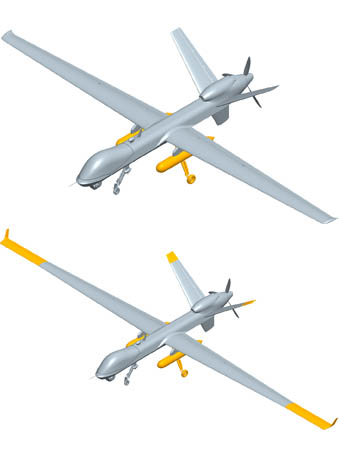General  Atomics Aeronautical Systems on Wednesday announced the near-term availability of two new extended-endurance configurations of its Predator B/MQ-9 Reaper remotely piloted aircraft. The first option optimizes the aircraft design for intelligence, surveillance, and reconnaissance missions, adding two fuel pods and heavy landing gear, to increase endurance from 27 hours to 37 hours, according to the company’s release. The second option optimizes the aircraft for multi-purpose missions, replacing the current 66-foot wings with 88-foot wings and adding a pair of fuel pods and heavy landing gear. These modifications increase endurance from 27 hours to 42 hours, stated the company. The two option are field-installable kits that extend endurance without the need for modifications in depot, said the company. Frank Pace, president of the company’s Aircraft Systems Group, said the new configurations are the result of a recent company-funded endurance-enhancement study. Earlier this year, GA-ASI announced a new trailing arm design for the Predator B/Reaper’s existing main landing gear, increasing gross-takeoff and landing weights.
Atomics Aeronautical Systems on Wednesday announced the near-term availability of two new extended-endurance configurations of its Predator B/MQ-9 Reaper remotely piloted aircraft. The first option optimizes the aircraft design for intelligence, surveillance, and reconnaissance missions, adding two fuel pods and heavy landing gear, to increase endurance from 27 hours to 37 hours, according to the company’s release. The second option optimizes the aircraft for multi-purpose missions, replacing the current 66-foot wings with 88-foot wings and adding a pair of fuel pods and heavy landing gear. These modifications increase endurance from 27 hours to 42 hours, stated the company. The two option are field-installable kits that extend endurance without the need for modifications in depot, said the company. Frank Pace, president of the company’s Aircraft Systems Group, said the new configurations are the result of a recent company-funded endurance-enhancement study. Earlier this year, GA-ASI announced a new trailing arm design for the Predator B/Reaper’s existing main landing gear, increasing gross-takeoff and landing weights.
Air Force Gen. Alexus G. Grynkewich assumed command of U.S. European Command on July 1, taking over the key assignment as the U.S. and its allies contend with a resurgent Russia and a grinding war in Ukraine.
